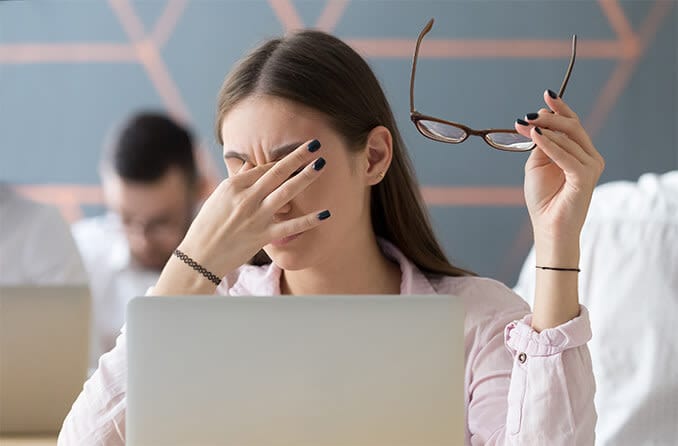Can Prolonged Screen Time Harm Your Eyes

This article aims to explore the potential impact of prolonged screen time on eye health.
It will delve into the concept of digital eye strain, examining its causes and the risks associated with blue light exposure.
Additionally, the article will provide guidelines for managing screen time to protect eye health, along with practical tips for reducing eye strain from digital devices.
Furthermore, the article will discuss the vision problems that can arise from excessive screen time and propose preventive measures to maintain healthy eyes in the digital age.
Key Takeaways
- Prolonged screen time can lead to digital eye strain, causing symptoms like eye fatigue, dryness, redness, and blurred vision.
- Decreased blinking frequency and increased eye focusing demands contribute to eye strain.
- Blue light emitted by screens can disrupt sleep patterns and contribute to eye strain.
- Implementing preventative measures, such as taking regular breaks, adjusting screen settings, and performing eye exercises, can help minimize the harm from prolonged screen time.
The Impact of Prolonged Screen Time on Eye Health
The potential negative effects of prolonged screen time on eye health are a topic of concern and research in the field of ophthalmology. One of the primary concerns is the development of digital eye strain, also known as computer vision syndrome, which encompasses a range of symptoms such as eye fatigue, dryness, redness, and blurred vision.
Prolonged screen time can lead to increased eye strain as individuals tend to blink less frequently and experience increased eye focusing demands. Additionally, the blue light emitted by digital screens has been shown to contribute to eye strain and disrupt sleep patterns.
To address these concerns, various organizations have provided screen time guidelines, recommending regular breaks, proper lighting, and maintaining a comfortable viewing distance to reduce the risk of eye strain.
However, further research is needed to fully understand the long-term effects of prolonged screen time on eye health.
Understanding Digital Eye Strain and Its Causes
This discussion will focus on prevention and mitigation techniques for digital eye strain, as well as the long-term effects it can have on vision.
Various strategies can be implemented to reduce the risk of developing digital eye strain, such as taking regular breaks, adjusting screen settings, and practicing proper ergonomics.
Additionally, understanding the potential long-term effects of excessive screen time on vision is crucial for individuals who frequently engage in digital activities.
Prevention and Mitigation Techniques
One effective approach to mitigate the potential harm of prolonged screen time on eyes is to implement preventative measures.
Preventing eye strain and incorporating eye exercises are two key strategies that can be employed.
Eye strain can be prevented by following the 20-20-20 rule, which involves looking away from the screen every 20 minutes and focusing on an object 20 feet away for 20 seconds. This helps to reduce eye fatigue and strain.
Additionally, performing regular eye exercises can help to strengthen the eye muscles and improve focus. Examples of eye exercises include blinking frequently to moisturize the eyes, rolling the eyes in different directions, and focusing on distant and close objects alternately.
Long-Term Effects on Vision
Implementing preventative measures and regularly performing eye exercises can help minimize the potential long-term effects of excessive screen use on vision. Prolonged screen time can have detrimental effects on eyesight, leading to various long-term consequences.
One of the primary effects is digital eye strain, which encompasses symptoms like dry eyes, blurred vision, and headaches. Studies have also indicated that excessive screen use can contribute to the development of myopia, or nearsightedness, particularly in children and adolescents.
Additionally, prolonged exposure to blue light emitted by screens can cause retinal damage and disrupt the sleep-wake cycle. These long-term consequences highlight the importance of implementing strategies to reduce screen time, taking regular breaks, and practicing eye exercises to alleviate the strain and protect visual health.
Blue Light Exposure: Risks and Effects on Vision
Blue light exposure has been extensively studied for its potential risks and effects on vision. Research suggests that prolonged exposure to blue light emitted from electronic devices, such as smartphones, tablets, and computers, may have several negative consequences on eye health.
Some of these risks and effects include:
- Increased risk of digital eye strain, leading to symptoms like dryness, redness, and blurred vision.
- Disruption of the sleep-wake cycle due to blue light’s impact on melatonin production, which can result in difficulty falling asleep and poor sleep quality.
- Increased risk of age-related macular degeneration, a condition that causes progressive damage to the central vision.
- Potential long-term damage to retinal cells, which may contribute to the development of conditions like cataracts and glaucoma.
To mitigate these risks, various strategies can be employed, such as reducing screen time, using blue light filters or screen protectors, and ensuring proper lighting and ergonomics while using electronic devices.
Screen Time Guidelines for Protecting Your Eyes
Research studies have provided guidelines for reducing the potential risks associated with excessive exposure to electronic devices. Screen time, especially in the form of prolonged use of smartphones, tablets, and computers, has been linked to various eye health issues. To protect your eyes from the negative effects of screen time, it is important to follow certain guidelines. The table below summarizes the recommended practices for reducing eye strain and maintaining good eye health while using electronic devices:
| Eye Health Guidelines for Screen Time |
|---|
| Take regular breaks |
| Maintain proper posture |
| Adjust screen brightness |
| Use the 20-20-20 rule |
| Limit screen time before bed |
Tips for Reducing Eye Strain From Digital Devices
To alleviate the strain on the eyes caused by digital devices, individuals can consider employing various strategies that focus on managing screen exposure and optimizing visual ergonomics. These strategies can help in reducing eye strain and preventing digital eye strain.
- Adjust the screen brightness to a comfortable level.
- Take regular breaks and practice the 20-20-20 rule, where every 20 minutes, look at something 20 feet away for 20 seconds.
- Maintain an appropriate distance between the eyes and the screen.
- Ensure proper lighting in the room to minimize glare and reflections on the screen.
By implementing these tips, individuals can reduce the risk of eye strain associated with prolonged screen time, promoting healthier visual habits and overall eye health.
It is important to prioritize the well-being of our eyes in this digital age.
Vision Problems Associated With Excessive Screen Time
Excessive exposure to digital devices has been linked to various vision problems, highlighting the need for individuals to adopt strategies that minimize screen time and prioritize eye health. Prolonged screen time can lead to eye strain, dry eyes, blurred vision, and discomfort.
One strategy to mitigate the negative effects of excessive screen time is to engage in regular eye exercises. These exercises can include focusing on distant objects, blinking frequently, and taking breaks from digital screens.
Additionally, the impact of screen time on sleep patterns is a concern. The blue light emitted by digital devices can suppress the production of melatonin, a hormone that regulates sleep. This can result in difficulty falling asleep and disrupted sleep patterns.
To minimize this impact, it is recommended to limit screen time before bed and utilize blue light filters on devices.
Preventive Measures for Maintaining Healthy Eyes in the Digital Age
This discussion will focus on preventive measures for maintaining healthy eyes in the digital age.
Three key points to be discussed are blue light protection, blinking and breaks, and regular eye exams.
Blue light protection refers to the use of specialized eyewear or screen filters to reduce the harmful effects of blue light emitted by digital devices.
Blinking and taking regular breaks from screen time are important to prevent eye strain and dryness.
Lastly, regular eye exams are crucial in detecting and addressing any underlying eye conditions that may be exacerbated by excessive screen time.
Blue Light Protection
Blue light protection is a topic of concern when discussing the potential harm of prolonged screen time on the eyes. Exposure to blue light emitted by electronic devices, such as smartphones, tablets, and computers, has been linked to various eye problems. To mitigate the negative effects of blue light, several preventive measures can be taken.
These include:
- Using blue light filters: Applying blue light filters on electronic devices can help reduce the amount of blue light reaching the eyes, thereby minimizing potential harm.
- Reducing screen time: Limiting the amount of time spent on electronic devices can significantly decrease blue light exposure and its associated risks.
- Taking regular breaks: Taking frequent breaks from screen time allows the eyes to rest and recover from the strain caused by blue light.
- Using proper lighting: Ensuring that the surrounding lighting is appropriate can help reduce eye strain and minimize the impact of blue light on the eyes.
Implementing these measures can contribute to maintaining healthy eyes in the digital age.
Blinking and Breaks
To maintain eye health during screen use, it is important to take regular breaks and blink frequently.
Extended periods of screen time can lead to discomfort and dryness in the eyes, known as computer vision syndrome (CVS).
One effective technique to combat this is the 20-20-20 rule, where every 20 minutes, individuals should look away from the screen and focus on an object 20 feet away for 20 seconds. This helps reduce eye strain and allows the eyes to relax.
Additionally, conscious blinking is crucial to combat dryness. When staring at a screen, individuals tend to blink less frequently, leading to dry eyes. By consciously blinking more often, the eyes stay lubricated and moist, reducing the risk of eye discomfort.
Therefore, incorporating regular breaks and practicing blinking techniques are vital for maintaining eye health during prolonged screen time.
Regular Eye Exams
Regular eye exams are essential for monitoring and detecting any potential vision problems or changes in eye health. These regular checkups play a crucial role in maintaining good eye care and overall well-being.
The importance of eye care cannot be overstated, as it helps identify early signs of eye diseases such as glaucoma, cataracts, and macular degeneration. Regular eye checkups can also detect refractive errors like myopia, hyperopia, astigmatism, and presbyopia, ensuring timely correction and preventing further deterioration of vision.
Additionally, these exams allow eye care professionals to assess eye health and provide personalized recommendations for preventive measures and lifestyle modifications. By prioritizing regular eye exams, individuals can proactively address any potential vision issues, promote eye health, and maintain optimal visual acuity for a better quality of life.
Frequently Asked Questions
How Can Prolonged Screen Time Affect Children’s Eye Health Differently From Adults?
Prolonged screen time may have different effects on children’s eye health compared to adults. It is necessary to consider the impact on children’s overall health and cognitive development when examining the effects of screen time.
Are There Any Specific Activities or Exercises That Can Help Alleviate Digital Eye Strain?
Activities and exercises can be beneficial in alleviating digital eye strain. These interventions aim to reduce the adverse effects of prolonged screen time on the eyes, promoting eye health and comfort.
What Are Some Signs or Symptoms of Blue Light Exposure Affecting Vision?
Signs or symptoms of blue light exposure affecting vision include eye strain, dryness, blurred vision, and difficulty focusing. Blue light can also disrupt sleep quality and potentially contribute to long-term effects on overall eye health.
Can Using Night Mode or Blue Light Filters on Digital Devices Completely Eliminate the Risks of Blue Light Exposure?
The effectiveness of night mode and blue light filters in reducing blue light exposure on digital devices has been studied. However, the impact of blue light on different age groups needs to be compared to determine their overall effectiveness.
Are There Any Long-Term Effects on Vision From Excessive Screen Time That Cannot Be Reversed?
Long-term effects of excessive screen time on vision may include digital eye strain, dryness, and myopia. While some of these effects can be reversed through prevention measures, others may require further investigation to determine their reversibility.









